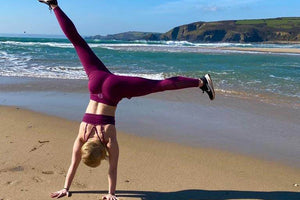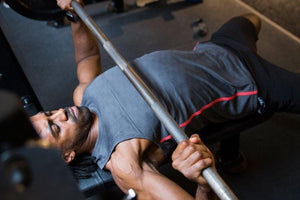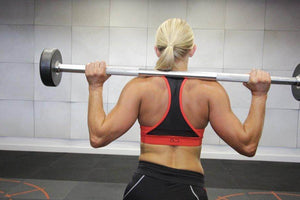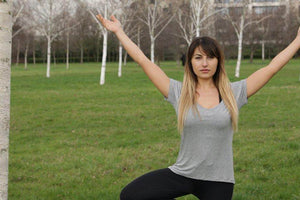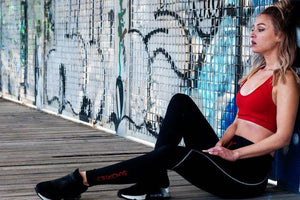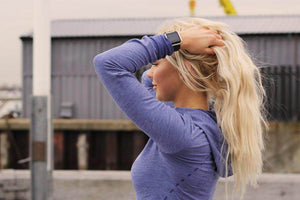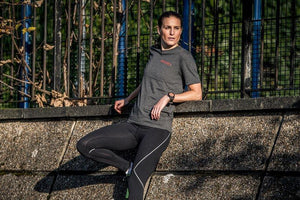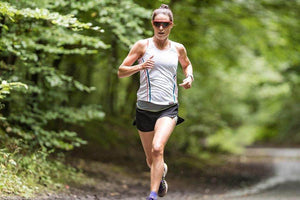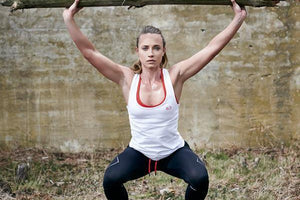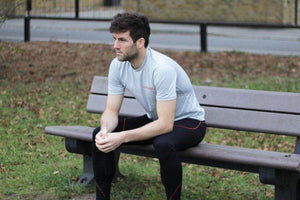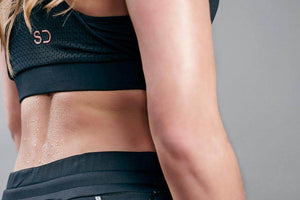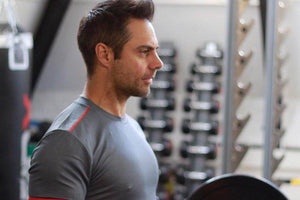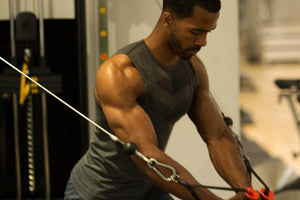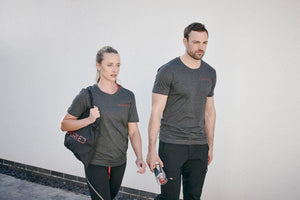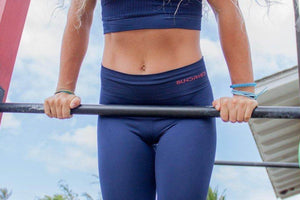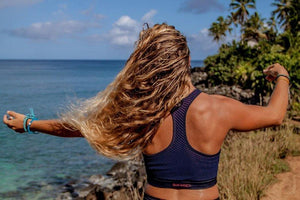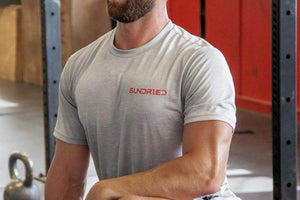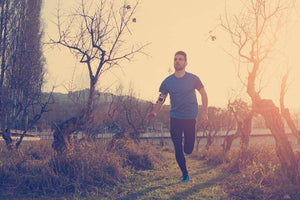
Activewear is now more popular than ever, but with the current rise of workout wear and so much choice being available, it can be hard to know your yoga pants from your running tights. We live in an age where fashion and fitness have exploded the market and left us with endless workout wardrobe possibilities, but how do you decide what to wear? This is your go-to guide to workout wear and everything fitness clothing.
Women's Gym Wear and Fitness Clothing
Base Layers
Think of your base layer as the foundation of your workout wardrobe. Base layers are so much more than just another layer in case you need to strip off during training. In fact, base layers should be a year round staple in your workout wardrobe. Base layers keep you warm when it’s cold by shielding you with an extra layer of insulation and wicking sweat away from your skin so that it doesn't make you cold.
Base layers are made most popular by cyclists as they can help save them from road rash and are often very aerodynamic in their second-skin fit. Whilst a base layer is no bulletproof vest, a good layer is designed to move with you, so if you're unfortunate enough to fall, the feeling of a base layer sliding across the pavement is better than the feeling of your skin shaving the pavement.
Base layers can also act as compression wear which has many benefits, including allegedly improving sports performance. Wearing a tight, compression layer under your gym clothes is thought to improve circulation and prevent muscle cramps so it is an important part of any workout wardrobe.
We recommend arming yourselves with two types of base layer, a long sleeve version for winter and a short sleeve for the sunshine. Look for a tight fit and high quality materials that wick sweat and sit comfortably when tight against your skin.
Sports Bras
As you bounce and jump during a workout, you can end up doing damage to your breast tissue if you don't have appropriate support. Especially if you have a larger bust, wearing the perfect sports bra is paramount to both comfort and health. When it comes to sports bras, ask yourself the following three questions:
1. Does it dig?
Whatever your sport or training regime, you need a good range of motion without irritation. Underarm rash is not only painful, it can restrict your range of motion. Take your new potential purchase to the changing room for some alone time and try moving around in it like you would if you were training.
2. Will it rub?
This is hard to tell from a changing room test, but after having a move around, if there is no digging or chafing, pull at the bra straps and see how much movement you get. Next test, how many fingers can you fit down the sides of the bra? It needs to be tight to support you whilst also allowing movement, ideally no more than a finger width. Too much movement of the bra will make it more likely to rub and means it probably lacks the support you bought it for in the first place.
3. Do they bounce?
If you’ve gotten away with dancing in the changing room, now it’s time to jump around. No matter how good your bra, there will always be a bit of a bounce during your workout, but this should be a small bounce. You should feel contained but still able to breathe.

Running Tights
Running tights need to be highly technical, functional, and comfortable so that they can go the distance with you. Running tights can now help wick away sweat, keep your body at the right temperature, and help aid blood circulation with their compression technology. Check out the features below to make sure you're getting the best running leggings for you.

Thickness
Tights come in a variety of thicknesses and depending on what time of year it is depends on what thickness is going to work best for you. Thicker tights, whilst great for extra warmth during winter, can often restrict your range of motion, be quite heavy to run in, or chafe. By contrast, tights which are too thin can leave your legs chilly, as well as risk being see-through when you bend over.
We recommend you take your tights through a changing room test, try out your range of motion, bend over and do a mirror check, it’ll save you the embarrassment of any potential flashing. Also, remember that lighting makes a difference; the changing room lighting can often be designed to hide these little details, so step outside your curtain and check out a mirror somewhere else in the shop to really be sure.
Waistband
There are two key tests for a waistband, does it sit comfortably without chafing and does it stay where it’s meant to. One of the worst things is having to continually interrupt your rhythm on a run to pull up your leggings. Typically, you will find three types of waistband: an elastic fit, a wide band fit, or a tie fit.
Elastic fits are great if the materials are high quality, but as you’re dependant fully on their bounce-back abilities, cheap materials can lack the support you need to keep your tights in place.
A wide waistband offers more comfort and is less likely to slip so easily. Tie waistlines ensure a secure fit but can be uncomfortable if you're wearing them for a long time as they can also be prone to chafing, so it’s worth investing in a pair with soft and smooth laces, that you don't have to pull too tightly for a snug fit.
Length
Whilst full length tights offer the most streamlined performance and heat protection, cropped leggings, sometimes referred to as Capri pants, are also very popular. These finish just below the knee and are great for those who run in warmer weather or who want a more versatile performance from their tights. ¾ lengths also work well for transitioning sports for example from wearing for running to yoga.

Yoga Pants
Your Yoga pants need to be flexible, even if you aren't. Yoga by nature requires a lot from your workout clothes. Yoga pants need to be flexible enough to fold into your pretzel and glide into your downward dog without revealing your polka dot panties. As yoga is less of a ‘sweat it out’ sport and more ‘oooooming’, we’re less concerned with sweat-wicking fabrics and more concerned with comfort and fit. Most yoga pants are made with cotton to allow your skin to breathe freely.
Hareem Style
Hareem pants are the ones which make you look like you’ve just walked straight out of Disney’s Aladdin. This hippy style loose fit pant is great for yoga as the loose fit allows freedom of movement with zero risk of camel toe. The fold over waist also ensures there are no builders bums in down dog.
Legging Style
The leggings style of yoga pants are form fitting to the point that next to nothing is left to the imagination. This style of yoga pant best shows off the form during yoga positions, allowing the instructor an unblocked view of the yoga forms. The tight fit on this style also means that there is no excess material to slip on.
Boot Cut/Flare
This is the type of yoga pant typically associated with the older woman. Women with larger thighs and hips may also prefer this style as the flare balances out the hips. This style of yoga pant clings to the upper thighs before gradually widening at the knee as it extends to the floor. The nature of the boot cuts versatile design means it’s great for transitioning from yoga to everyday life.
Compression Gear
Compression wear is your second skin, think of this as your moment to release your inner superhero with workout clothes that are super snug. There is a lot of clever marketing hype when it comes to compression wear, with claims that compression can help to improve thermoregulation, reduce muscle oscillation, and increase circulation, however research to support this seems to be limited, so it could be more opinion than fact.
Research in The International Journal of Sports Psychology and Performance found that when compression clothing was applied for recovery purposes after exercise in recovery of maximal strength and power, there were reductions in muscle swelling and perceived muscle pain, blood lactate removal, and increased body temperature suggesting that the application of compression clothing can assist athletic performance and recovery.
There are also studies that show performance improvements in other types of activities, such as endurance cycling. Researchers in Australia noted that there was an increased concentration of oxygen in cyclists’ muscles when they were wearing compression sleeves. They also took a longer amount of time to reach anaerobic threshold.
Research has however found that compression has little benefits for endurance runners, a study published by The International Journal of Sports Physiology and Performance, rounded up 16 competitive male distance runners. They were fixed with monitors measuring their gait, oxygen intake, and other variables and then hit the treadmill and ran at three different speeds. Compression sleeves were slipped over calves, and the treadmill test was repeated, the New York Times reported. Results showed that there were no statistically significant differences in running efficiency or biomechanics between when the runners wore compression and when they didn’t. If the sleeves had functioned as expected, the runners would have used less oxygen.
For those who are packing a little extra weight, compression wear also gives them the extra confidence of knowing everything is supported and nothing is going to ‘jiggle’ if this is the difference between getting out there or staying in, compression has got to be the way forward, regardless of the other benefits!
Workout Jackets
Winter workouts can be cold, hell, we live in the UK, summer workout can be cold! The perfect jacket should keep you warm whilst training while remaining comfortable and fashionable enough for wear when you're not working out, whether you’re dashing off to do your shopping or lounging around the house. The top things to look out for when selecting a workout jacket are warmth and visibility. If you are training in the cold winter, chances are it’s going to be getting darker quicker as well, so if you're pounding the pavements, visibility is crucial to stay safe. Look for clothing with reflective strips such as our Grand Combin and Monte Rosa. As well as keeping you warm, it’s safe to say that as we live in the UK, your jackets going to need to help keep you from getting wet, look for waterproof materials to make sure you don’t end up getting (too) soggy.
Workout Tops
The workout top is an absolute staple in your workout wardrobe but getting it wrong can leave you chaffed, soggy and sporting sweat patches you can’t even hide with your arms down.
Wicking-ability
If you're training hard enough, you're going to be doing some serious sweating, so you need a top which will keep you dry and comfortable. Both Polyester and Lycra tops are safe choices as they keep you warm in winter and cool in summer, as well as drying quickly.
Tip: If you want to avoid the iron, opt for a polyester blend, you can hang them straight from washing and they’ll still stay crease free.
Layerable
Your workout tops need to be versatile to get the most bang for your buck, you want a top you can strip down to in summer but layer up during the winter. Investing in a good quality top which can be layered throughout the seasons is a real investment for your workout wardrobe.

Coverage
Consider the activities you do most, and make sure the clothes you buy are comfortable and appropriate for that activity. You don’t want a top that's going to flash your stomach as you reach up to lat pull down, or a cut so low you tumble out your top whenever you bend over.
Now we’ve got your clothing covered, all that’s left to pick is your shoes…
but you can never have too many pairs of trainers!



